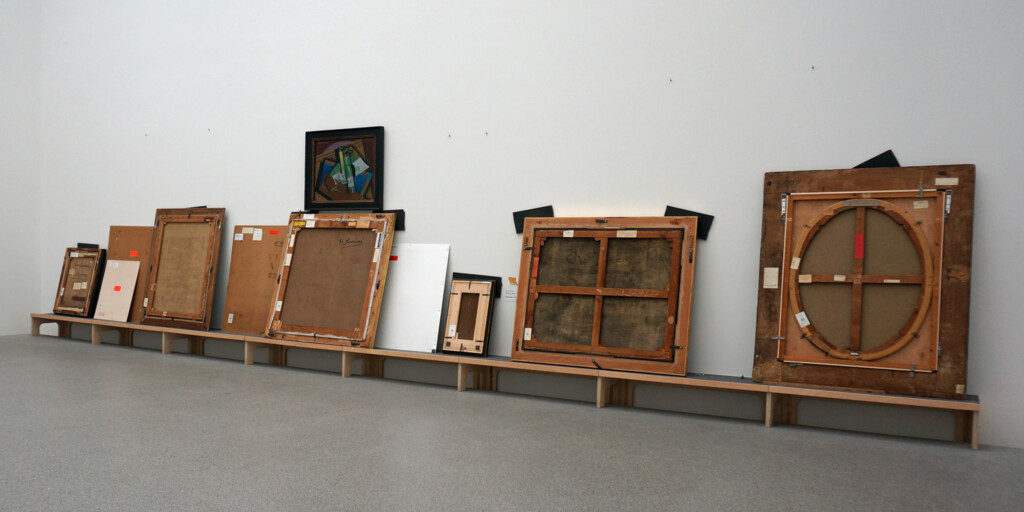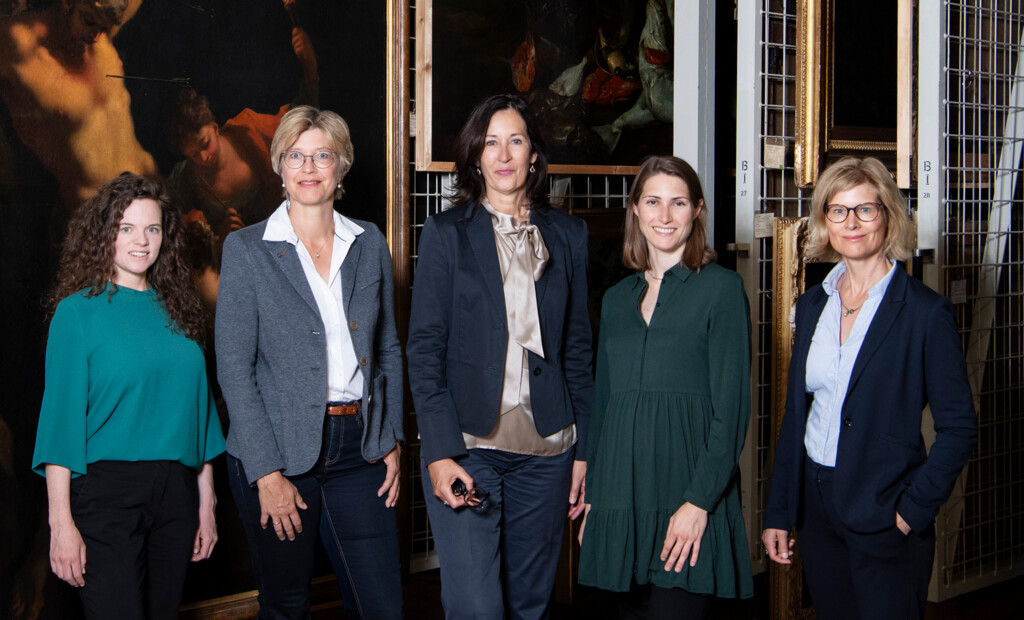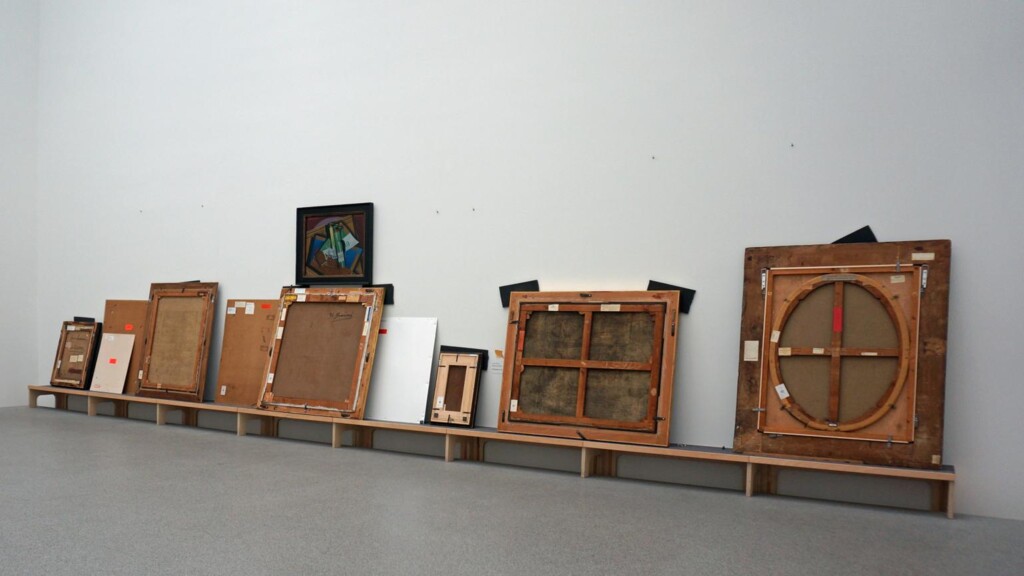
Provenance research
Provenance research
Provenance Research at the Pinakotheken
Please note that when you play the video, cookies are stored on your device and a connection to the USA is established. The USA is not a safe third country in the sense of EU data protection law. With your consent, you also agree to the processing of your data in the USA. You can find further information in our privacy policy.
About Provenance Research
The Bayerische Staatsgemäldesammlungen (Bavarian State Painting Collections) conducts research into the provenance of artworks that were acquired or catalogued from 1933 onwards and whose ownership history is unclear. In accordance with the principles agreed at the Washington Conference on Holocaust Era Assets that was held in 1998, the Bayerische Staatsgemäldesammlungen continually inspects its holdings at the Pinakothek museums and affiliated galleries in order to determine whether any of its artworks were unlawfully expropriated from Jewish owners during the period of National Socialism in Germany. Our objective is to compile seamless provenance documentation for each work, wherever possible, so that ownership issues can be clarified more easily.
SYSTEMATIC PROVENANCE RESEARCH SINCE 1999
The Bayerische Staatsgemäldesammlungen first created a position dedicated to provenance research in 1999, limited to a period of three years. Until 2002, Ilse von zur Mühlen surveyed the museum’s holdings and compiled a catalogue for the 125 works from the former Göring collection, which was published in 2004. In 2006, the investigated works in this report were reported to www.lostart.de on suspicion of theft. In 2008, the museum set up its own department for provenance research to which a full-time conservation specialist was appointed, i.e., the position was made permanent. Since then, Dr. Andrea Bambi has been examining the provenance of artworks that were made before 1945 and acquired by the museum in or after 1933.
PROACTIVE EXAMINATION OF 6000 WORKS
In addition to the systematic research of 6,000 works in the inventory (paintings and sculptures), the department deals with both incoming restitution claims and proactively detected cases. It reports these to www.lostart.de for suspected loss through persecution and, if possible, it approaches the entitled beneficiaries. Furthermore, it handles and realizes processes relevant to provenance, such as new acquisitions of works of art created before 1945, loans, database entries and catalogue entries.
The staff members of the department regularly take part in advanced training courses, workshops and conferences on provenance and art market research. The Bayerische Staatsgemäldesammlungen are a member of the research network Provenance Research Bavaria and the researchers actively participate in the Arbeitskreis Provenienzforschung e. V. (Association for Provenance Research).
News
Research Focus
These art and cultural objects, which were also formerly known as “transfers from state ownership”, used to belong to collections of former NSDAP officials and organizations. They were transferred to the Free State of Bavaria on the basis of directives by the Allied Control Council, especially in the 1950s and 1960s. Around 900 of these artworks were subsequently included in the holdings of the Bayerische Staatsgemäldesammlungen, where – due to their origins – they form one of the most problematic groups of works to be researched. This stock has been handled by Dr. Florian Wimmer † (from November 2013 until November 2015), by Dr. Johannes Gramlich (from 1 July 2016 until September 2022) and Anja Zechel M.A. (from November 2012 until May 2017) and Sophie Kriegenhofer (August 2018 until December 2020).
From March 2015 until March 2018, 238 selected works of classical modernism have been examined by Johanna Poltermann. The research situation regarding these works is complex, since they were not acquired directly by the Pinakotheken, but were largely donated to the collection in the post-war period. Important groups of works include, for example, the former private collections of Woty and Theodor Werner, Martha and Markus Kruss, Günther Franke as well as Sofie and Emanuel Fohn. Some of these collections were formed in the Weimar Republic, in the time of National Socialism or even in the post-war period, which is why the actual historical circumstances surrounding their purchase have to be subjected to critical examination.
The works acquired between 1933 and 1945 were inspected for theft at the Collecting Point in Munich in the immediate post-war period, a second fundamental review was carried out between 1999 and 2002. Since the summer of 2017, this stock comprising 1000 works of art is being reassessed for theft by Anja Zechel and Melida Steinke (August 2018 until December 2020) on the basis of newly accessible sources and updated as to their provenance details.
The aim of the project was to be able to exclude all those artworks which show a clear and in every aspect unsuspicious provenance from further research while taking into account that in the course of the initial inspection that was based on the written tradition of inventories and pictorial records, and the state of knowledge today, which has developed considerably compared to the years around 1998/2000. The total scope of the initial check in question here amounted to over 4000 artworks. The project manager until December 2020 was Dr. Ilse von zur Mühlen.
Staff
The Provenance Research Department at the Bayerische Staatsgemäldesammlungen has three permanent and two temporary members of staff.
Head: Dr. Andrea Bambi, art historian, full-time position (senior conservator)
Substitute: Dr. Theresa Sepp, art historian, full-time position
Staff member: Anja Zechel, M.A., historian, part-time position
Project Art, Theft and Restitution
Project coordination: Dr. Julia Devlin (temporary)
Mediation: Dr. Anna Valeska Strugalla (temporary)

Restitutions
Ongoing Restitutions
Jacob Ochtervelt, Das Zitronenscheibchen (The Lemon Slice) (Inv.-Nr. 16217)
On 1 July, 2020, the Advisory Commission recommended that the work should be restituted to the heirs of Carl Hagen. The restitution of the painting is intended to contribute to the recognition and rectification of historical injustice. The recommendation is available on the Advisory Commission's website. The Bayerische Staatsgemäldesammlungen are in contact with the family and are preparing the restitution.
Lesser Ury, Kinderszene (Children's scene) (Inv.-Nr. 14275)
On the basis of the scientific dossier of the Provenance Research Department, the Bavarian State Ministry of Science and Art, in agreement with the Bayerische Staatsgemäldesammlungen, decided to restitute the painting to the heirs of Curt Goldschmidt as soon as all heirs can be fully identified.
Case Dismissals
In a decision dated September 28, 2018, the U.S. Federal District Court in New York, which was called upon by the heirs of Alfred Flechtheim, approved a motion to dismiss previously filed by the Free State of Bavaria on its own behalf and on behalf of the Bayerische Staatsgemäldesammlungen (cf. Jahresbericht (annual report) 2017). With the present decision, the court proceedings in New York are now concluded. The case was dismissed for lack of jurisdiction of the U.S. court due to the immunity of the Free State of Bavaria under the U.S. Foreign Sovereign Immunities Act. The court did not make any findings of fact in this regard, but dismissed the action because the court would not have had jurisdiction even if the plaintiffs had been able to prove the facts alleged in their statement of claim.
The heirs of Paul von Mendelssohn-Bartholdy filed a lawsuit against the Free State of Bavaria in the USA in 2013 regarding the Picasso painting "Madame Soler". The lawsuit was dismissed in two instances for lack of jurisdiction of American courts due to the immunity of the Free State of Bavaria under the U.S. Foreign Sovereign Immunities Act. Most recently, the US Supreme Court in Washington D.C., the highest constitutional court in the USA, also rejected the lawsuit in January 2016.
The request for restitution of the painting "Madame Soler", which was first submitted to the Bayerische Staatsgemäldesammlungen in 2009, was carefully examined. Based on the provenance research, the decision-makers of the Free State Bavaria/Bayerische Staatsgemäldesammlungen came to the conclusion that the documented sale of the painting from the Mendelssohn-Bartholdy collection to the art dealer Thannhauser, from whose son Justin Thannhauser the Free State of Bavaria/Bayerische Staatsgemäldesammlungen purchased the painting in 1964, did not constitute a Nazi persecution-related seizure in the sense of the Washington Principles, i.e. the painting is not a restitution case.
The assessments conducted by internal and external experts in 2010 and 2013 also reached this conclusion. Further information on the provenance of the painting "Madame Soler" by Pablo Picasso can be found on the website of the Bayerische Staatsgemäldesammlungen: PDF | Basic information on the provenance of the painting "Madame Soler" by Pablo Picasso. The Washington Principles, to which the Free State of Bavaria is committed and in accordance with which numerous restitutions have already been made, presuppose for restitutions that it is a matter of a persecution-related seizure.
Reports of Findings
The Bayerische Staatsgemäldesammlungen lists research findings on www.lostart.de.
In cases where theft or loss caused by Nazi persecution cannot be completely ruled out, the works are registered on the Lost Art website. The online database is open to the public and provides access to the most up-to-date information on the paintings so that potential owners can come forward with their claims. The number of works listed on Lost Art is constantly increasing and demonstrates that the Bayerische Staatsgemäldesammlungen takes its responsibility to inspect its collections and to report looted-art very seriously. 379 artworks are currently listed on Lost Art.
Research into the works is ongoing. Our provenance researchers are consulting additional resources in an attempt to fill in gaps in the chain of ownership and fully clarify the origins of the paintings and sculptures.

Insights into the work
It is important to us to provide information about the activities of provenance research at the Bayerische Staatsgemäldesammlungen. Here we recently offered insights into our work:
- On the 4th International Provenance Research Day in April 2022, the Bayerische Staatsgemäldesammlungen presented the results of their research on the "Acquisitions 1933-1945" in a blog. The article "The 'Acquisitions 1933-1945' of the Bayerische Staatsgemäldesammlungen: Project Results and Impulses" is available at RETOUR. FREIER BLOG FÜR PROVENIENZFORSCHENDE.
- Recording of the talk "FACE TO FACE - Marc Chagall a 'Degenerate' Artist" on 11 November 2021: To the video.
- Book launch on 11 March 2021 of the publication: "Begehrt, beschwiegen, belastend. Die Kunst der NS-Elite, die Alliierten und die Bayerischen Staatsgemäldesammlungen" (Coveted, Concealed, Incriminating. The Art of the Nazi Elite, the Allies and the Bavarian State Painting Collections) by Johannes Gramlich: To the recording of the live stream
- In February 2021, Anja Zechel was a guest at the Jewish Museum Augsburg Schwaben to talk about the restituted painting "Bauernstube" (Farmhouse Parlour) from the Friedmann Collection: To the recording of the live stream
- Live stream of the 2nd International Provenance Research Day in April 2020 with Andrea Bambi
- Publication "Raub von Kulturgut" (Theft of Cultural Property)
In January 2015, the city of Munich, the Städtische Galerie im Lenbachhaus, the Jewish Museum and the Bayerische Staatsgemäldesammlungen agreed on a cooperation project with the Chair of Contemporary History at the University of Erfurt, Prof. Dr. Christiane Kuller. As part of the project, contemporary historian Dr. Jan Schleusener has been investigating the confiscation of art objects set in motion in mid-November 1938 from Jewish art dealers or those considered Jewish in the sense of Nazi racial terminology and other owners of art in Munich and the surrounding area. - Alfred Flechtheim - Art Dealer of the Avant-Garde: Until March 2014, 15 museums showed artworks in exhibitions and on the website www.alfredflechtheim.com that are connected to Alfred Flechtheim's galleries through their provenance. The works on display came into the respective collections via various routes: the museums acquired some of them directly from Alfred Flechtheim, either as a purchase, gift or through his mediation. Other works were sold by him to third parties and came to the museums via several intermediate stations - mostly after 1945.
On this page you will also find articles on past restitutions.
The blog of the Bayerische Staatsgemäldesammlungen also offers numerous insights into the work of the provenance research department.
Documentary "Looted Art" on 3sat
Documentary "Geraubte Kunst. Jüdische Sammlungen im Nationalsozialismus" (Looted Art. Jewish Collections under National Socialism) by Felix von Boehm and Constantin Lieb.
Dr. Andrea Bambi, Head of Provenance Research and Cultural Property Export at the Bayerische Staatsgemäldesammlungen gives insights into her work and the research on the painting "Revival of Lazarus", which was restituted in 2017.
Looted, dismantled and sold: Jewish art collections - often collected over generations - were systematically expropriated after the National Socialists seized power in Germany. Using selected cases, the documentary by Felix von Boehm and Constantin Lieb shows how the art market profited from the predicament of many Jewish collectors after 1933 and the difficulties that provenance research still faces today in the search for lost objects.
Please note that when you play the video, cookies are stored on your device and a connection to the USA is established. The USA is not a safe third country in the sense of EU data protection law. With your consent, you also agree to the processing of your data in the USA. You can find further information in our privacy policy.
Publications
- Die Auslagerungsdepots der Bayerischen Staatsgemäldesammlungen im Zweiten Weltkrieg für staatliche und private Bestände; In: Die Reise der Bilder. Hitlers Kulturpolitik, Kunsthandel und Einlagerungen in der NS-Zeit im Salzkammergut. Ausst. Kat. Lentos Kunstmuseum Linz 2024, S. 167 - 173.
- The great art dealers had not always made money by selling paintings but by holding on to them." Kundenbindung und Netzwerke am Beispiel der Galerie Stern in Düsseldorf; In: Entrechtet und beraubt. Der Kunsthändler Max Stern. Ausst. Kat. Stadtmuseum Düsseldorf 2021, S.156-165.
- Alfred Flechtheim. Wegbereiter der Avantgarde. In: Provenire. Schriftenreihe des Deutschen Zentrums Kulturgutverluste, Magdeburg Provenienzforschung in deutschen Sammlungen. Einblicke in zehn Jahre Projektförderung. Deutsches Zentrum Kulturgutverluste, Magdeburg (Hrsg.), Berlin 2019, S. 225-232.
- On the tasks of provenance research, livestream via YouTube
- Blog post on restitution of the painting "Resurrection of Lazarus"
- Provenance research in home office: Article on Hypotheses
- Begehrt, beschwiegen, belastend. Die Kunst der NS-Elite, die Alliierten und die Bayerischen Staatsgemäldesammlungen (Coveted, Concealed, Incriminating. The Art of the Nazi Elite, the Allies and the Bavarian State Painting Collections) (Publishings of the Bavarian State Painting Collections 4), Vienna a.o., 2021.
- With Stephan Kellner (ed.): Activity Report of the Research Network Provenance Research Bavaria 2019, Passau 2020.
- „Die Zeit drängt & überall sind Schattenseiten“ ("Time is pressing & there are shadows everywhere"). The Abraham Adelsberger Collection and the Painting Fishing Boats at Frauenchiemsee by Josef Wopfner. Explaining the research results and basis for restitution, in: Bernhard Maaz (ed.), annual report of the Bayerischen Staatsgemäldesammlungen 2019, Munich 2020, pp. 100-111.
- Hildebrand Gurlitt auf dem französischen Kunstmarkt. Handel und Bürokratie (Hildebrand Gurlitt on the French Art Market. Trade and bureaucracy), in: Andrea Baresel-Brand a. o. (eds.), Kunstfund Gurlitt. Wege der Forschung (Provenire 2) (Art Find Gurlitt. Ways of Research (Provenire 2)), Berlin, Boston 2020, pp.48-62.
- WithCarola Thielecke: Provenance Research as a Voluntary Obligation, in: Deutsches Zentrum Kulturgutverluste (Hrsg.), Provenance Research Manual to Identify Cultural Property Seized Due to Persecution During the National Socialist Era, 2020.
- With Jochen Meister, blog post: The "Four Elements" by Adolf Ziegler
- Blog post: Provenance research in the home office
- The Gap was the Evidence, 'A Restitution Report on the Friedmann Case', Annual Report of the Bayerische Staatsgemäldesammlungen 2018, Munich 2019, pp. 176-183.